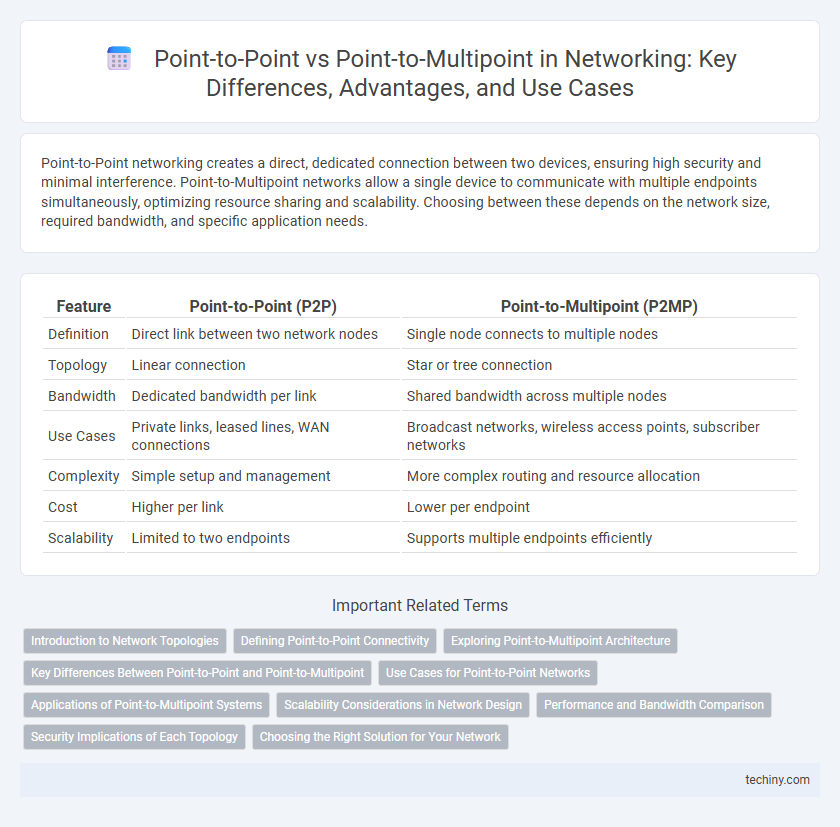Point-to-Point networking creates a direct, dedicated connection between two devices, ensuring high security and minimal interference. Point-to-Multipoint networks allow a single device to communicate with multiple endpoints simultaneously, optimizing resource sharing and scalability. Choosing between these depends on the network size, required bandwidth, and specific application needs.
Table of Comparison
| Feature | Point-to-Point (P2P) | Point-to-Multipoint (P2MP) |
|---|---|---|
| Definition | Direct link between two network nodes | Single node connects to multiple nodes |
| Topology | Linear connection | Star or tree connection |
| Bandwidth | Dedicated bandwidth per link | Shared bandwidth across multiple nodes |
| Use Cases | Private links, leased lines, WAN connections | Broadcast networks, wireless access points, subscriber networks |
| Complexity | Simple setup and management | More complex routing and resource allocation |
| Cost | Higher per link | Lower per endpoint |
| Scalability | Limited to two endpoints | Supports multiple endpoints efficiently |
Introduction to Network Topologies
Point-to-point topology connects two network nodes directly, providing a dedicated communication link that ensures high-speed and secure data transfer. Point-to-multipoint topology allows a single node to communicate with multiple nodes, optimizing bandwidth usage in applications like wireless networks and broadband access. Understanding these topologies helps in designing efficient network architectures tailored to specific performance and scalability requirements.
Defining Point-to-Point Connectivity
Point-to-point connectivity establishes a direct communication link between two devices or nodes, ensuring dedicated bandwidth and minimal latency for predictable network performance. This type of connection is commonly used in private networks, leased lines, and fiber optics where high security and reliability are critical. Unlike multipoint configurations, point-to-point links are simpler to manage and optimize due to their exclusive nature.
Exploring Point-to-Multipoint Architecture
Point-to-multipoint architecture enables a single central node to communicate simultaneously with multiple endpoints, optimizing bandwidth utilization and reducing infrastructure costs compared to point-to-point connections. This topology is ideal for wireless networks, broadband access, and distribution networks, where scalable and efficient data transmission is crucial. Key technologies supporting point-to-multipoint setups include Multiprotocol Label Switching (MPLS), Wi-Fi mesh, and broadband wireless access standards like LTE and 5G.
Key Differences Between Point-to-Point and Point-to-Multipoint
Point-to-Point (P2P) networking involves a direct link between two devices, providing dedicated bandwidth and low latency ideal for secure communication or data transfer. In contrast, Point-to-Multipoint (P2MP) connects one central device to multiple endpoints, optimizing resource allocation and scalability often used in wireless ISP configurations or multicast services. The key differences lie in bandwidth allocation, network complexity, and use case scenarios, with P2P offering consistent performance while P2MP enhances network reach and cost-efficiency.
Use Cases for Point-to-Point Networks
Point-to-point networks are ideal for direct, high-capacity communication between two locations, commonly used in connecting office buildings, data centers, or campuses. These networks provide low latency and high security, making them suitable for voice, video conferencing, and data transfer where performance and reliability are critical. Typical use cases include dedicated leased lines for enterprise WANs, fiber optic links for backbone networks, and wireless microwave links in remote or hard-to-wire environments.
Applications of Point-to-Multipoint Systems
Point-to-multipoint systems are widely used in wireless internet service providers (WISPs) to deliver broadband connectivity from a single base station to multiple customer premises. These systems efficiently support applications such as video surveillance, smart grid communications, and IoT device networks by enabling scalable and cost-effective data transmission over extended areas. Additionally, point-to-multipoint architectures facilitate urban and rural telecommunication infrastructure by reducing the need for physical cabling and allowing rapid deployment.
Scalability Considerations in Network Design
Point-to-point connections provide dedicated bandwidth and low latency for each link, but scalability is limited as each new device requires a separate connection, increasing complexity and cost. Point-to-multipoint architecture enables a single central device to communicate with multiple endpoints, improving scalability by reducing the number of physical links and simplifying network management. Scalability considerations favor point-to-multipoint designs in large deployments where minimizing infrastructure and optimizing resource allocation are critical.
Performance and Bandwidth Comparison
Point-to-Point connections provide dedicated bandwidth, ensuring higher performance and lower latency by directly linking two nodes without sharing resources. In contrast, Point-to-Multipoint setups distribute bandwidth among multiple endpoints, which can lead to congestion and reduced individual throughput during peak usage. Performance in Point-to-Point networks is optimal for high-demand applications, while Point-to-Multipoint configurations support simultaneous connections at the cost of potential bandwidth limitations.
Security Implications of Each Topology
Point-to-Point (P2P) topology offers enhanced security by establishing a direct, dedicated connection between two devices, reducing the risk of unauthorized access or data interception compared to Point-to-Multipoint (P2MP) networks. P2MP topology, while efficient for distributing data to multiple locations, inherently increases vulnerability due to shared communication paths and the need for robust encryption protocols to prevent eavesdropping and man-in-the-middle attacks. Implementing strong authentication mechanisms and encryption standards like WPA3 or AES is critical in Point-to-Multipoint configurations to mitigate the expanded attack surface.
Choosing the Right Solution for Your Network
Choosing between point-to-point and point-to-multipoint networks depends on the specific requirements of your infrastructure, such as bandwidth needs, scalability, and geographic distribution. Point-to-point connections deliver dedicated high-speed links ideal for connecting two locations with consistent performance and low latency. Point-to-multipoint setups provide scalable solutions for linking multiple endpoints, offering cost efficiency and simplified management in environments with diverse device connectivity demands.
Point-to-Point vs Point-to-Multipoint Infographic

 techiny.com
techiny.com